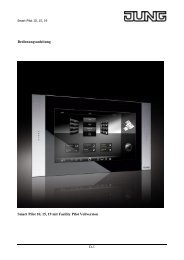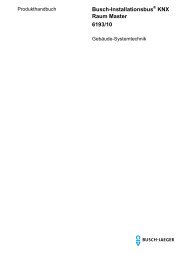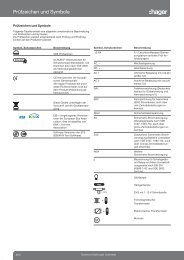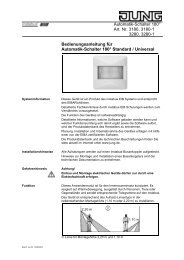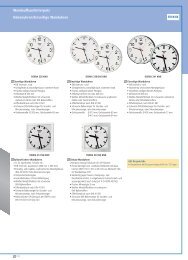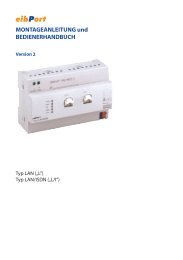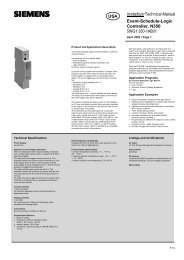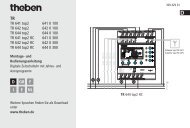You also want an ePaper? Increase the reach of your titles
YUMPU automatically turns print PDFs into web optimized ePapers that Google loves.
i The functionality of the datalogger, in particular the configuration of the datalogger channels,<br />
is dealt with in more detail in the "Datalogger" chapter of this documentation (see<br />
page 99).<br />
Access check:<br />
A display element with the "Access check" function possesses a 4 bit communication object. In<br />
the communication object, three bytes represent a code number and one byte contains various<br />
information, encoded by bit.<br />
The other parameters are used to define whether the code number is displayed or a text corresponding<br />
to a bit from the status byte.<br />
Restraint:<br />
A display element with the "Restraint" function possesses a 1 bit object and a 2 bit object.<br />
it can display texts for the four possible values of the 2 bit object. The value of the 1 bit object is<br />
not displayed.<br />
Operating mode switch:<br />
Depending on the "Operating mode switch via" parameter, a display element with the "Operating<br />
mode switch" function will have one 1 byte object or four 1 bit objects.<br />
When using the 1 byte object, the display element can display five operating statuses...<br />
- 0 = Automatic mode<br />
- 1 = Comfort mode<br />
- 2 = Standby mode<br />
- 3 = Night mode<br />
- 4 = Frost/heat protection<br />
When using the four 1 bit objects, these have the following internal ranking...<br />
- Frost/heat protection (highest priority)<br />
- Comfort<br />
- Standby<br />
- Night (lowest priority)<br />
The object with the highest priority, with the value "1" determines the operating mode shown by<br />
the display element. If all four objects have the value "0", the display then switches to Comfort<br />
mode.<br />
Collective feedback:<br />
After central commands or the return of bus voltage, the telegram load of a bus line is usually<br />
high, as many bus devices, such as switching actuators, transmit the status of their communication<br />
objects as feedback. This effect increases when each switching channel of an actuator initialises<br />
in this manner. To keep the telegram load low during 'bus initialisation', collective feedback<br />
can be used for some actuators. The collective feedback summarises the switching status<br />
of all the outputs of an actuator in just one telegram. The 32 bit communication object "Collective<br />
feedback" contains bit-orientated feedback information of up to 16 switching channels (see<br />
picture 13).<br />
Order-No. 7574 00 1X<br />
Software "...590101"<br />
Functional description<br />
Page 58 of 222




